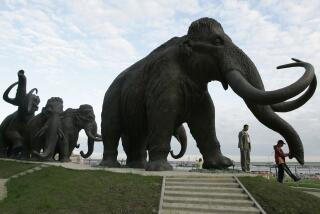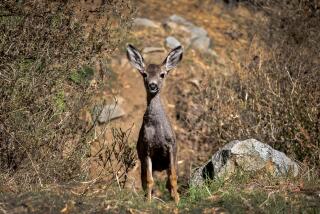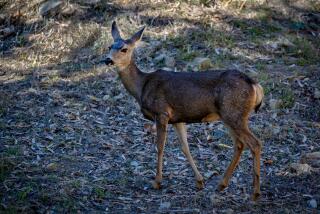Bio-Bullet Seen as Life-Saver for Africaâs Free-Ranging Wildlife
SKUKUZA, South Africa â An American inventor and wildlife researchers at Kruger National Park say they have achieved a major breakthrough in conservation--an immunization system that can stop epidemics in free-ranging animals.
The breakthrough is the bio-bullet, a vaccine in a biodegradable projectile that can be fired by an air rifle from a helicopter. It has been used for three years to immunize animals ranging from wart hogs to elephants against diseases that have nearly wiped out species in the park, a 7,800-square-mile reserve.
Anthrax is endemic in the northern part of the park, an area where 200 rare roan antelope roam. Before 1970, when the park began an inoculation program by firing disposable darts at the animals from the air, severe outbreaks had affected most of the herd animals.
âIf we have another major outbreak, we have a method now of controlling the epidemic,â said Valerius de Vos, head of research at Kruger. âI consider this a major breakthrough. . . . It will be used widely in the future.â
How widely depends to some extent on politics. While South Africaâs wildlife management program is regarded as the best on the continent, its experts seldom visit other African countries where similar problems exist. Black African governments restrict contact with South Africa because of apartheid, its system of racial separation.
âWe Need Interactionâ
âItâs a pity,â De Vos said. âThe rest of Africa needs us and we need them. Weâve got expertise and we need interaction.â
For instance, the numbers of endangered black rhinoceroses are increasing in South Africa but declining elsewhere. Due to South African conservation efforts, the white rhino was removed from the endangered category worldwide.
Representatives of private wildlife groups sometimes come to South Africa, and exchanges take place by mail, but many Western universities wonât send copies of research papers to Krugerâs scientists.
Gus Mills, the chief predator researcher, made a tape recording of hyena territorial cries and plays it from a jeep at night.
âAll the hyena in the area come around to listen and we can count them,â he said. âIâve sent my tape to Kenya and now Kenyan hyenas are listening to South African hyenas.â
De Vos said the air rifle that fires the bio-bullet can be locally produced, but not the bullet itself. He worries what sanctions could disrupt the immunization program.
Four-Wheel Drive Vehicles
There has been talk of banning shipments of four-wheel drive vehicles to South Africa from Japan, because they have military potential.
âThatâs going to affect us,â De Vos said. âI donât know what weâre going to do, but I guess we can keep going with two-wheel drive vehicles.â
In 1973 De Vos and his team began inoculating large mammals by firing dart-syringes from the air. Disadvantages included large numbers of plastic darts left on the ground, and the time and cost of manufacturing the syringes.
De Vos found Fred Paul, an inventor from White Bear Lake, Minn., who had developed the bio-bullet and used it to vaccinate domestic livestock and wild bighorn sheep. Paul came to Kruger Park to assist the research, which included firing different-sized bullets at varying velocities until the right size and shape were determined.
The bullet can be fired rapidly, allowing marksmen to inoculate about 1,500 animals a day with 80% accuracy. The material, a cellulose polymer, dissolves inside the animal, releasing the vaccine.
âImpressiveâ Accuracy
Vaccinating 1,500 animals a day with 80% accuracy is âimpressive, to say the least. . . . Thatâs a lot of animals,â said Maurice LeFranc, director of the Institute for Wildlife Research, a branch of National Wildlife Federation in the United States.
The South African park lends itself to such an effort because it has wide open spaces and concentrations of animals, LeFranc said in Vienna, Va.
The project illustrates the place that South African wildlife researchers have in the forefront of species preservation and the National Park Boardâs philosophy about when to let nature take its course and when man should intervene.
âSouth Africa has taken a real strong leadership in the preservation and conservation of their wildlife,â said Dr. Werner Heuschele, an endangered species specialist at the San Diego Zoo in California. âSome of their game parks are among the best managed in the world.â
One researcher at Kruger is capturing impala to find a cure for a human-caused stress disease that occurs when antelope are chased for long distances and caught in a net. In the wild, predators chase impalas only for short distances.
Research by Surveillance
The main form of research at Kruger is surveillance--taking aerial photos of vegetation, counting animals, taking blood levels of elephants to see if car exhaust affects them. The data is fed into computers to help determine what projects are needed in the park, a fenced area the size of Massachusetts.
Roads affect the natural spread of fire, so controlled fires are set deliberately. Fenced animals cannot migrate during drought, so dams are built.
In the early 1970s, wildebeest rapidly diminished. A new fence around the park had cut off one herdâs traditional migration route, and heavy rainfall encouraged long grass, rather than the short grass the wildebeest like.
Managers could have set fires to eliminate the tall grass. Instead, they decided to kill off lions and hyenas who preyed on the wildebeest.
To prevent the need for such action in the future, Mills and his team spend two weeks at a time following lions, cheetah and leopards, to monitor their eating habits.
Researches Want to Know
âAre they depressing the prey in large numbers or living in harmony with their environment?â Mills says researchers want to know.
Although anthrax and foot-and-mouth disease are natural African diseases, they are controlled because it would take 20 to 30 years for the herds to recover after an endemic outbreak.
âDrastic fluctuations in animal populations are part of nature, but we canât afford that,â said De Vos.
âWe cull (shoot) buffalo and elephant, and sometimes hippo. These are species that can outgrow the system. The rest of the animals are controlled by the system. Drought, predation, disease all act as controls. For the buffalo and elephant, the main predator in the past was man. We have taken man out of it, so now weâre bringing man back in, in a controlled way.â
More to Read
Sign up for Essential California
The most important California stories and recommendations in your inbox every morning.
You may occasionally receive promotional content from the Los Angeles Times.










